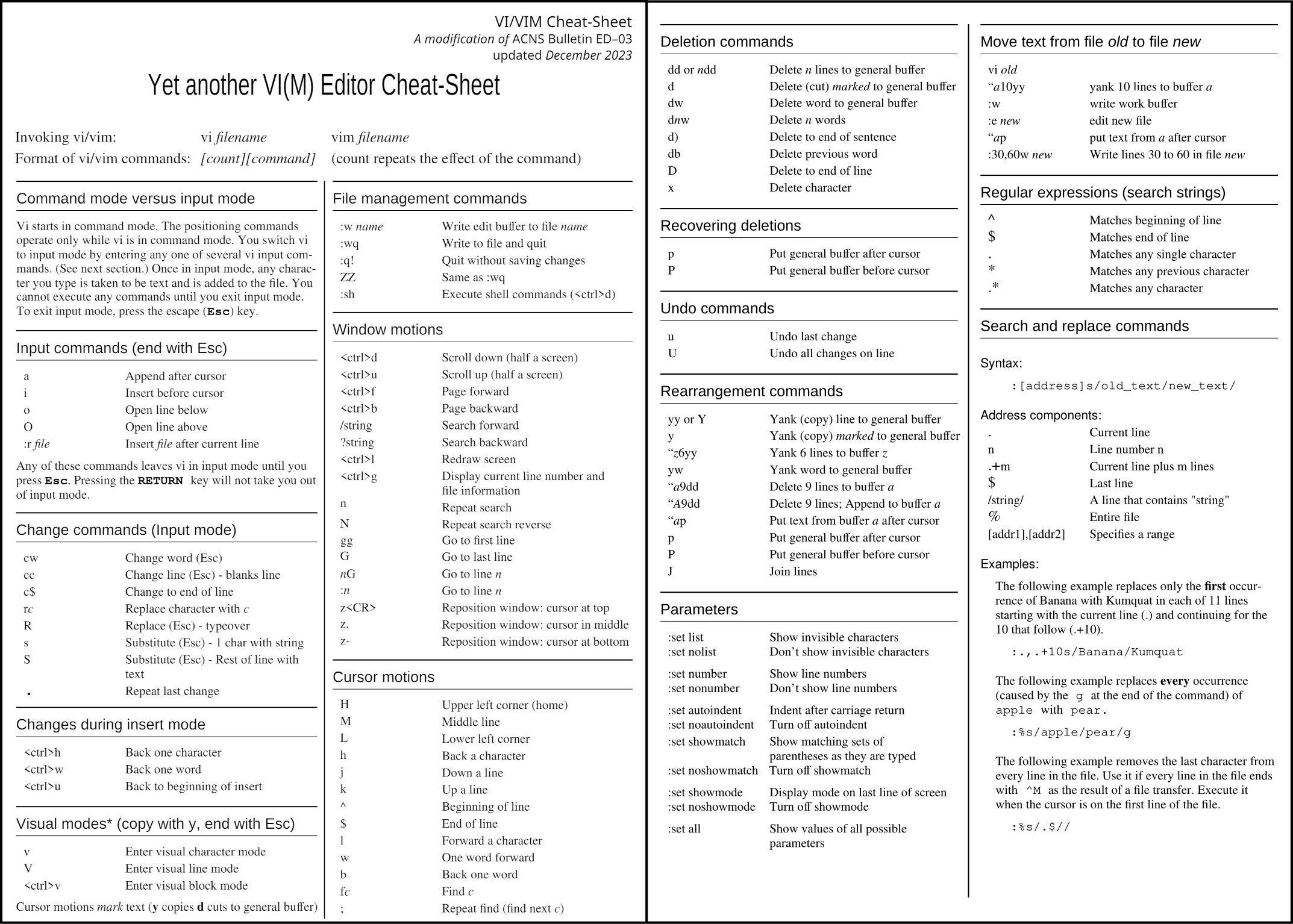As I tend to forget how to invoke the most essential vi functionality I am in the desperate need of a vi/vim cheat sheet, which is why I stumbled across the vi Editor “Cheat Sheet” from the University at Albany, that, with just very few additions, fits my needs for an everyday vi cheat sheet perfectly.
Command mode versus input mode Input commands Change commands Changes during insert mode Visual modes File management commands Window motions Cursor motions Deletion commands Recovering deletions Undo commands Rearrangement commands Parameters Move text from file old to file new Regular expressions (search strings) Search and replace commands Further reading
Invoking vi(m): vi <filename> (vim <filename>), format of vi(m) commands: [count][command] (count repeats the effect of the command)
Vi (vim) starts in command mode. The positioning commands operate only while vi is in command mode. You switch vi to input mode by entering any one of several vi input commands (see next section). Once in input mode, any character you type is taken to be text and is added to the file. You cannot execute any commands until you exit input mode. To exit input mode, press the escape (<ESC>) key.

| a |
Append after cursor |
| i |
Insert before cursor |
| o |
Open line below |
| O |
Open line above |
:r <file> |
Insert <file> after current line |
Any of these commands leaves vi in input mode until you press <ESC>. Pressing the <RETURN> key will not take you out of input mode.
| cw |
Change word (<Esc>) |
| cc |
Change line (<Esc>) - blanks line |
| c$ |
Change to end of line |
| rc |
Replace character with c |
| R |
Replace (<Esc>) - typeover |
| s |
Substitute (<Esc>) - 1 char with string |
| S |
Substitute (<Esc>) - Rest of line with text |
| . |
Repeat last change |
Changes during insert mode
<CTRL>h |
Back one character |
<CTRL>w |
Back one word |
<CTRL>u |
Back to beginning of insert |
Visual modes (copy with y, end with Esc)
| v |
Enter visual character mode |
| V |
Enter visual line mode |
<CTRL>v |
Enter visual block mode |
Cursor motions mark text (y copies d cuts to general buffer).
:w <name> |
Write edit buffer to file <name> |
| :wq |
Write to file and quit |
| :q! |
Quit without saving changes |
| ZZ |
Same as :wq |
| :sh |
Execute shell commands (<CTRL>d) |
<CTRL>d |
Scroll down (half a screen) |
<CTRL>u |
Scroll up (half a screen) |
<CTRL>f |
Page forward |
<CTRL>b |
Page backward |
| /string |
Search forward |
| ?string |
Search backward |
<CTRL>l |
Redraw screen |
<CTRL>g |
Display current line number and file information |
| n |
Repeat search |
| N |
Repeat search reverse |
| gg |
Go to first line |
| G |
Go to last line |
| nG |
Go to line n |
| :n |
Go to line n |
z<CR> |
Reposition window: cursor at top |
| z. |
Reposition window: cursor in middle |
| z- |
Reposition window: cursor at bottom |
| H |
Upper left corner (home) |
| M |
Middle line |
| L |
Lower left corner |
| h |
Back a character |
| j |
Down a line |
| k |
Up a line |
| ^ |
Beginning of line |
| $ |
End of line |
| l |
Forward a character |
| w |
One word forward |
| b |
Back one word |
| fc |
Find c |
| ; |
Repeat find (find next c) |
| dd or ndd |
Delete n lines to general buffer |
| d |
Delete (cut) marked to general buffer |
| dw |
Delete word to general buffer |
| dnw |
Delete n words |
| d) |
Delete to end of sentence |
| db |
Delete previous word |
| D |
Delete to end of line |
| x |
Delete character |
| p |
Put general buffer after cursor |
| P |
Put general buffer before cursor |
| u |
Undo last change |
| U |
Undo all changes on line |
| yy or Y |
Yank (copy) line to general buffer |
| y |
Yank (copy) marked to general buffer |
| “z6yy |
Yank 6 lines to buffer z |
| yw |
Yank word to general buffer |
| “a9dd |
Delete 9 lines to buffer a |
| “A9dd |
Delete 9 lines; Append to buffer a |
| “ap |
Put text from buffer a after cursor |
| p |
Put general buffer after cursor |
| P |
Put general buffer before cursor |
| J |
Join lines |
| :set list |
Show invisible characters |
| :set nolist |
Don’t show invisible characters |
| :set number |
Show line numbers |
| :set nonumber |
Don’t show line numbers |
| :set autoindent |
Indent after carriage return |
| :set noautoindent |
Turn off autoindent |
| :set showmatch |
Show matching sets of parentheses as they are typed |
| :set noshowmatch |
Turn off showmatch |
| :set showmode |
Display mode on last line of screen |
| :set noshowmode |
Turn off showmode |
| :set all |
Show values of all possible parameters |
vi <old> |
|
| “a10yy |
yank 10 lines to buffer a |
| :w |
write work buffer |
:e <new> |
edit <new> file |
| “ap |
put text from a after cursor |
:30,60w <new> |
Write lines 30 to 60 in file <new> |
| ^ |
Matches beginning of line |
| $ |
Matches end of line |
| . |
Matches any single character |
| * |
Matches any previous character |
| .* |
Matches any character |
Syntax: :[address]s/old_text/new_text/
Address components
| . |
Current line |
| n |
Line number n |
| .+m |
Current line plus m lines |
| $ |
Last line |
| /string/ |
A line that contains “string” |
| % |
Entire file |
[addr1],[addr2] |
Specifies a range |
Examples
The following example replaces only the first occurrence of Banana with Kumquat in each of 11 lines starting with the current line (.) and continuing for the 10 that follow (.+10).
The following example replaces every occurrence (caused by the g at the end of the command) of apple with pear.
The following example removes the last character from every line in the file. Use it if every line in the file ends with ^M as the result of a file transfer. Execute it when the cursor is on the first line of the file.
Further reading



